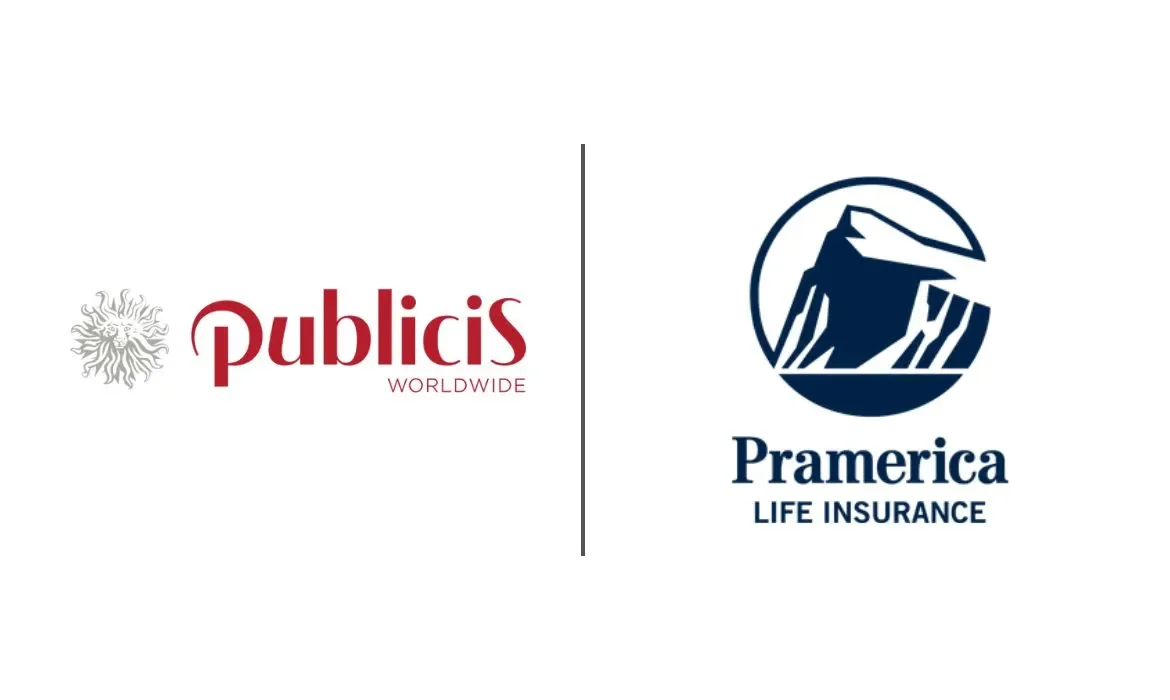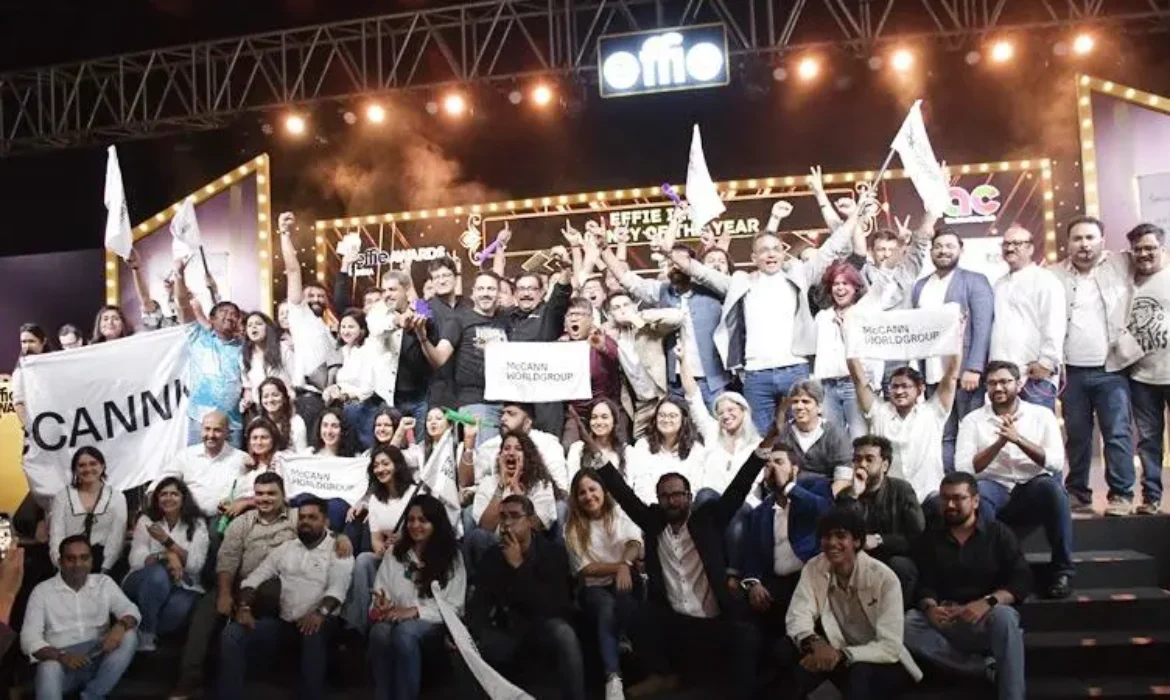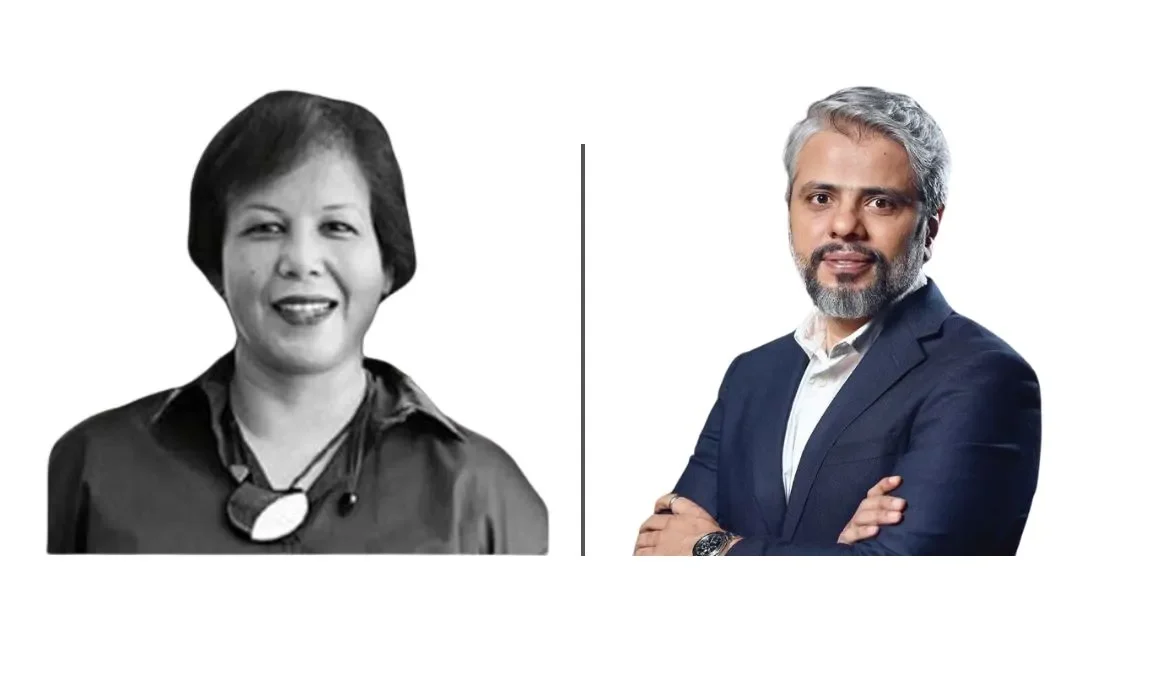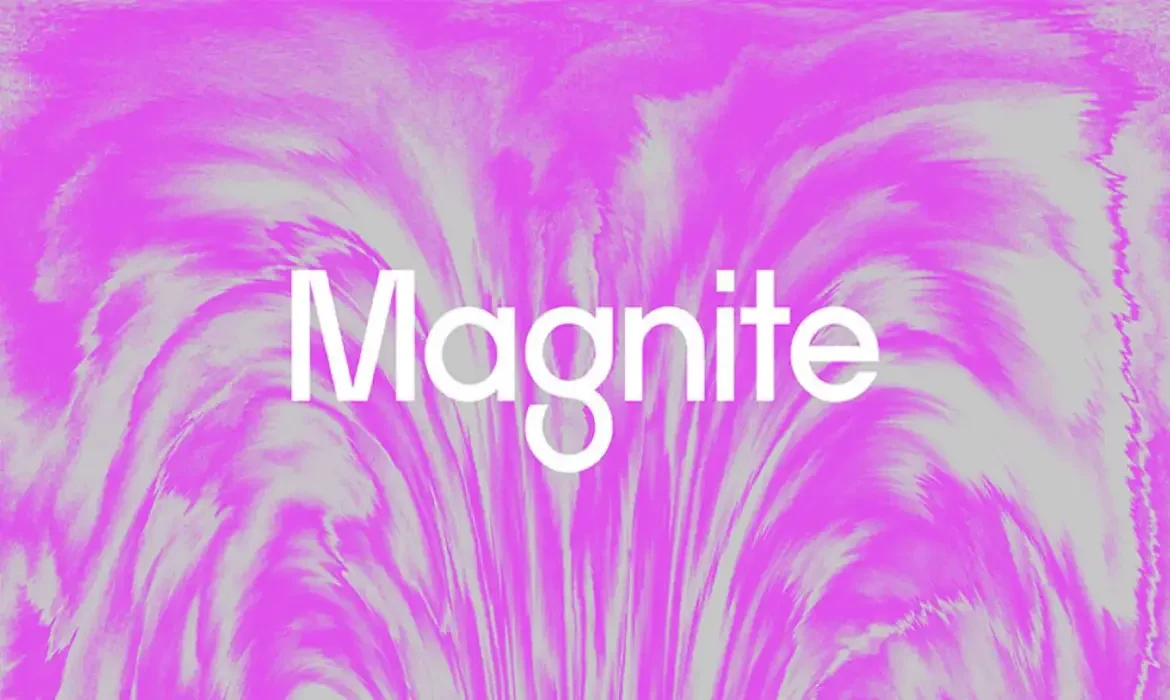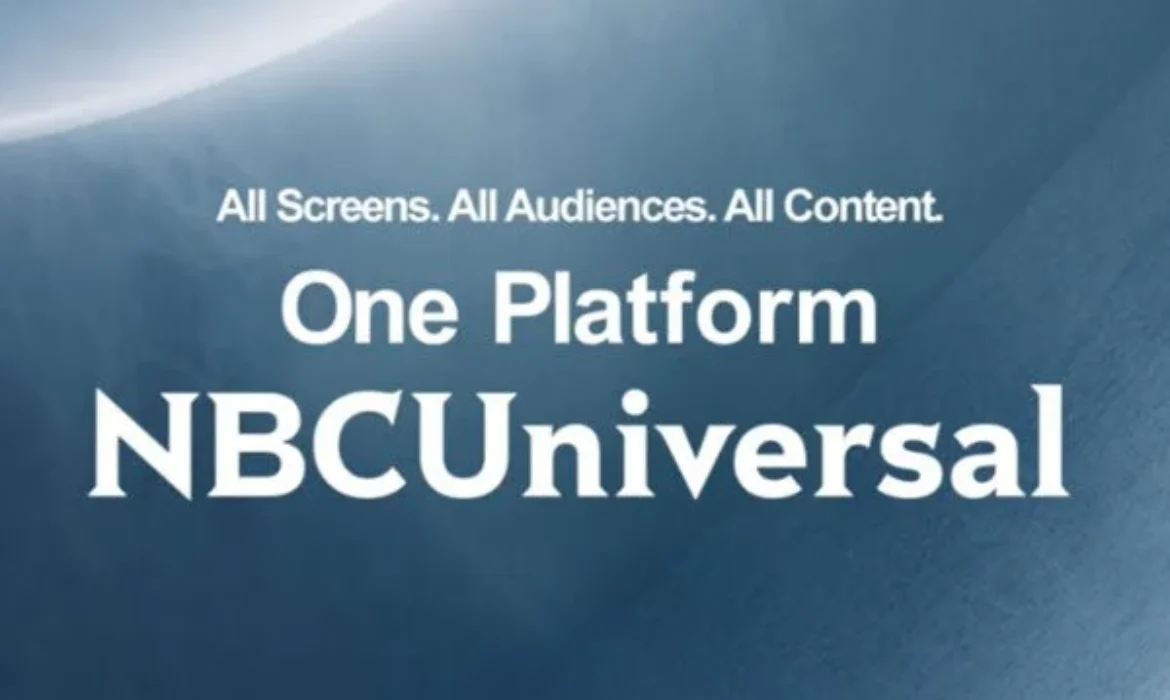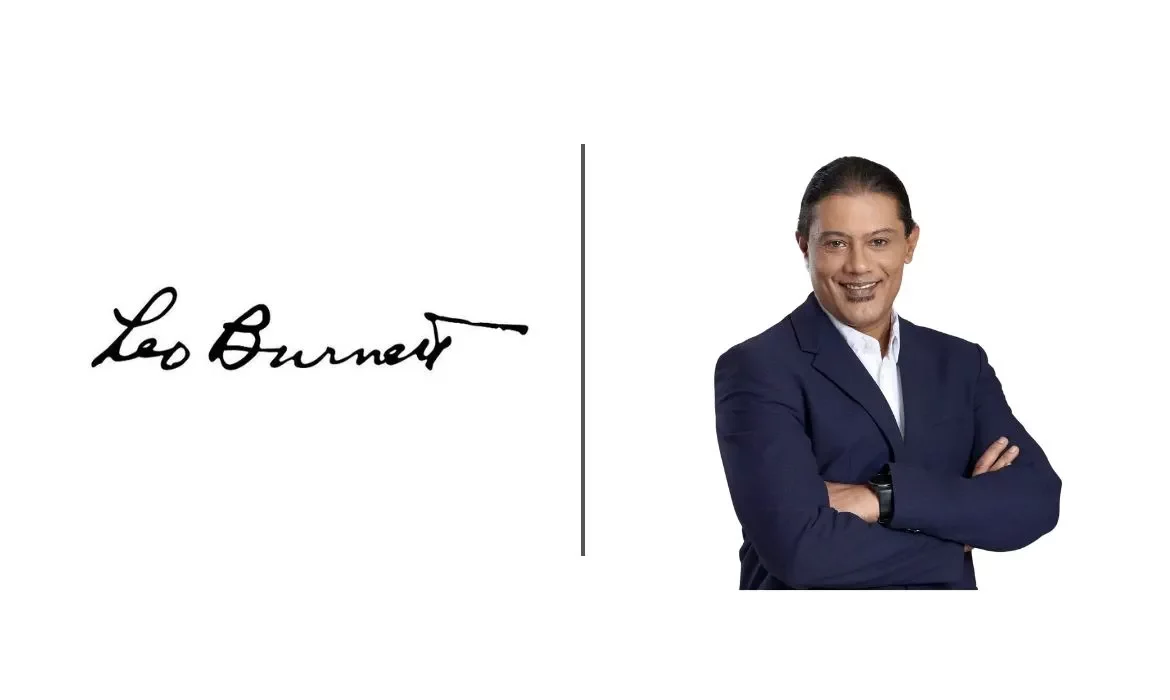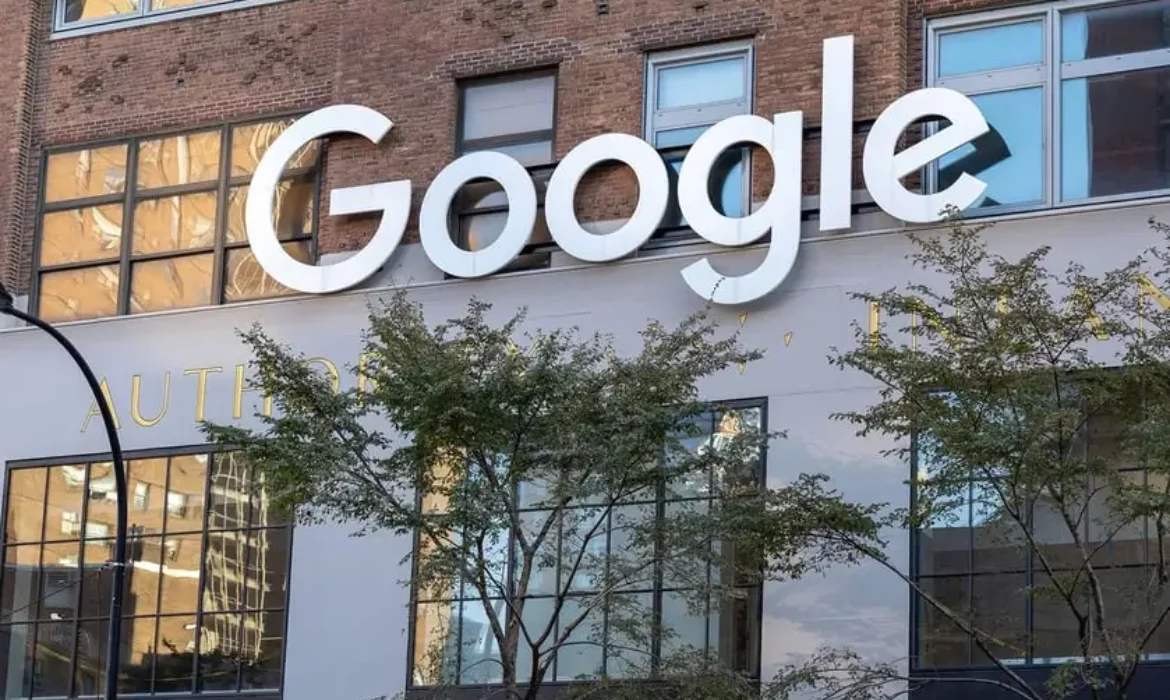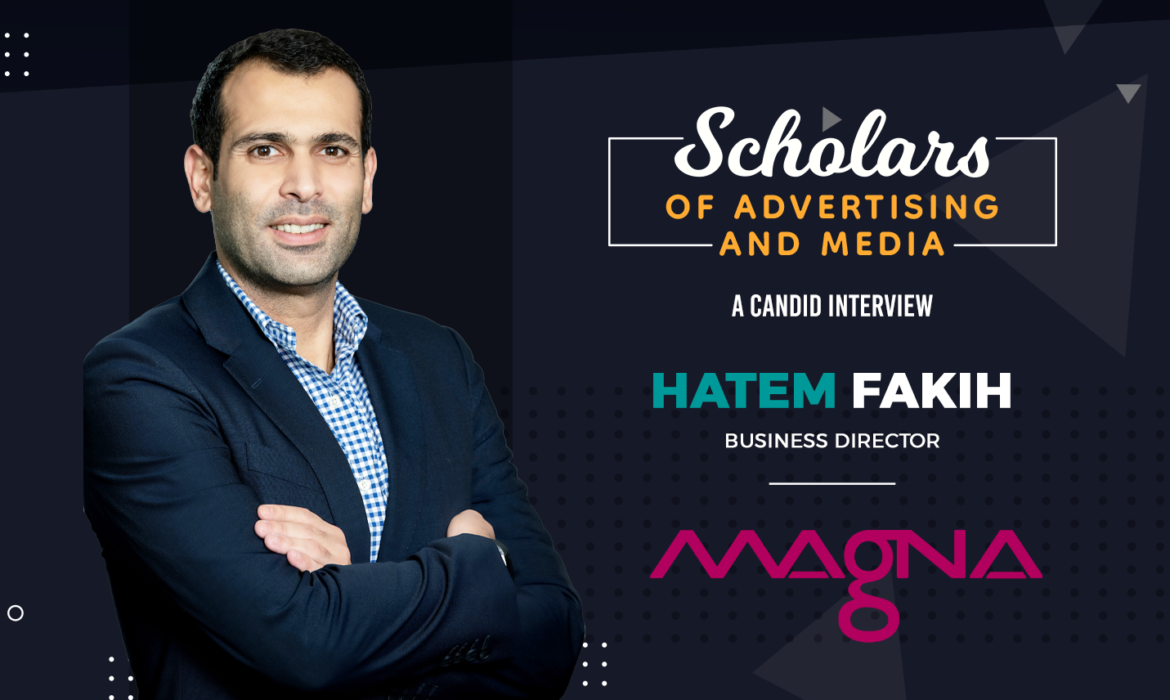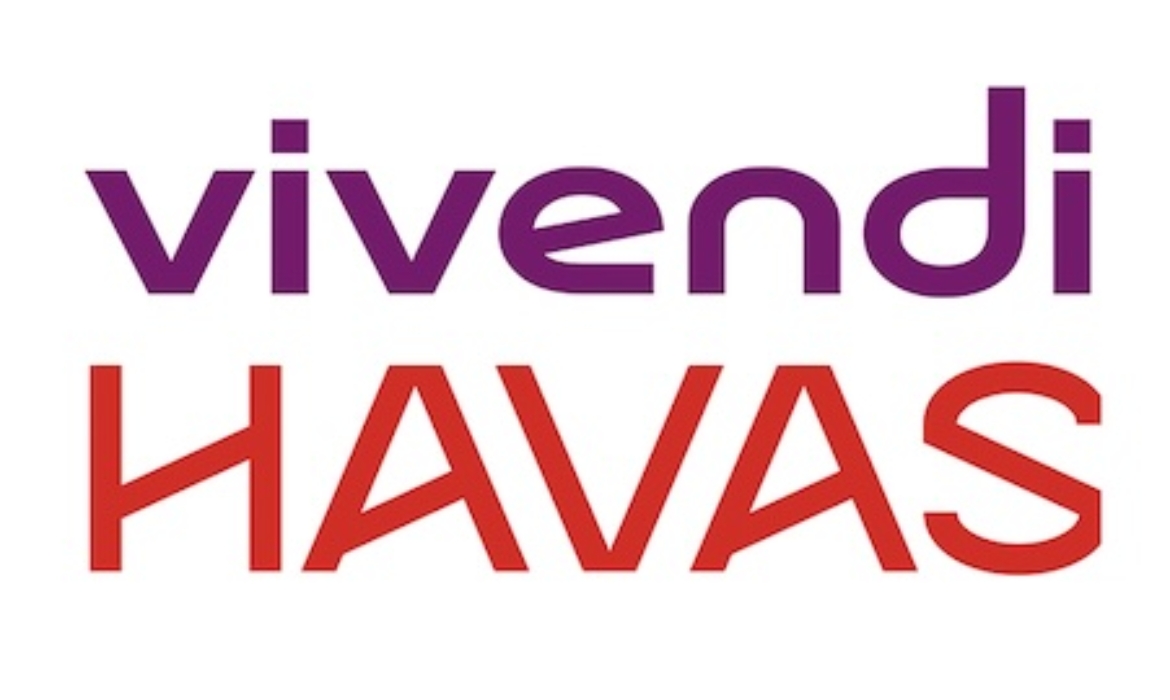Publicis Worldwide India Wins Creative Mandate for Pramerica Life Insurance
Publicis Worldwide India, a division of Publicis Groupe India, has been awarded the integrated creative mandate for Pramerica Life Insurance. The agency has started a moving and motivational two-part digital campaign for the brand called “This is my Climb” as part of the mandate.
Publicis Worldwide bags creative mandate
The first movie shows the family of defense personnel, demonstrating the men in uniform’s unwavering devotion and dedication. Additionally, it honors the unsung heroes and reaffirms Pramerica Life’s commitment to supporting them and their families through all of life’s obstacles.
In the second movie, a father uses all his strength and sacrifice to support his child’s dreams, putting aside his own ambitions and goals in the process. The dedication of Pramerica Life Insurance to helping people at every stage of their ascent is demonstrated in both movies.
Purpose of the story
Stories of purpose, hope, and resilience are portrayed in the campaign, and they speak to people of all ages. It delves deeply into the emotional core of human experiences through powerful short films. Furthermore, it skillfully fusing the themes of purpose and resilience in people’s “This is my climb” narratives.
Read More: Saatchi & Saatchi Bags Ibis Global Strategy and Creative Business
Here’s what they said
Amaresh Jena, Chief Marketing Officer at Pramerica Life Insurance said,
This is my Climb is not just a campaign; it’s a manifestation of our brand’s aspirations and goes beyond storytelling, embodying Pramerica Life Insurance’s core goals. Our objective is to imbue each life we touch with a profound sense of security and empowerment, echoing our vision. Aligned with our mission to be a trusted friend, guiding individuals to informed insurance choices, the campaign aims to provide support during life’s challenges and inspire enduring confidence.
Oindrila Roy, Managing Director at Publicis Worldwide India, added,
We are thrilled to be partnering Pramerica Life Insurance. It is a highly respected brand with a strong commitment to providing innovative and customer centric life insurance solutions. We are confident that our deep understanding of the category coupled with our creative expertise will help Pramerica exceed its business goals in India.
Srijan Shukla and Pratheeb Ravi, ECD’s at Publicis Worldwide India stated,
The campaign is conceptualized around a simple truth that there are challenges and struggles in everyone’s life. But it is these climbs and struggles beyond which lie real success. These climbs might seem very ordinary but are in fact tough on the individuals who actually face them. Pramerica Life wanted to be a partner in these extraordinary climbs of ordinary people. The films focus on the lives of ordinary people and celebrate the moment when they decide to take up the climb. We wanted to keep the stories honest and authentic so that the audience resonates with them.
Read More: Häagen-Dazs Names BBH As Its Global Lead Creative Agency
McCann Worldgroup Wins EFFIE India Agency of the Year
McCann Worldgroup won the EFFIE India Agency of the Year award at the 2023 The Advertising Club’s EFFIE India Awards. Ogilvy India took second place, followed by Leo Burnett. Mondelez India was named the EFFIE Client of the Year, and Enormous won the coveted Grand EFFIE for Jaguar’s “Unimaginable Brand Extensions” campaign.
The EFFIE India Awards 2023
The awards recognized agencies and clients for their outstanding work in marketing and advertising communication, which established new standards for effectiveness. With participation from 79 agencies, EFFIE India received a record-breaking 1,276 entries this year, the highest in its 23-year history.
EFFIE is widely acknowledged as a strong testament to an agency’s capacity for brand development. It continuously stands at the pinnacle of advertising efficacy, praising and recognizing a campaign for its creative strategy, well-executed execution, and powerful messaging.
Top 5 Agencies
Leading the pack with eight gold, fourteen silver, and eleven bronze was McCann Worldgroup. Followed by Ogilvy with six gold, ten silver, and eleven bronze. Leo Burnett (three Gold, nine Silver, and nine Bronze), DDB Mudra (two Gold, seven Silver, and seven Bronze), and MullenLowe Lintas Group (seven Silver and six Bronze) complete the top five.
Read More: Publicis Groupe South Asia Appoints Amitesh Rao as CEO, Leo Burnett South Asia
Here’s what they said
Prasoon Joshi, CEO, McCann World Group India and Chairman, APAC said,
I am extremely delighted and proud of McCann winning the Agency of the Year at the Effie India 2023 Awards. Today, In the world’s changing landscape where our industry faces extreme challenges in defining the approach to the future, McCann India is an organisation which holds ideas and thinking at the core of our business and propels our bossiness and clients forward. Effectiveness comes from this culture of belief in creative excellence driven by strong consumer insights. This is McCann India’s hallmark supported by a robust our McCann Global’s culture of strong creative and strategic leadership. What is remarkable is the the width and the diverse set of businesses, we have won awards for Ujjivan Small Finance Bank, Nestle India, MasterCard, Reckitt, Dabur, Hero and many others as mentioned.
Rana Barua, President, The Advertising Club, stated,
The EFFIEs stand as a testament to the power of impactful storytelling and strategic brilliance in our industry. My heartfelt gratitude to the advertising fraternity for their unwavering support, making these awards a celebration of creativity and effectiveness. Congratulations to all the winners for crafting campaigns that not only captivate but also leave a lasting impact on our audiences. Your creativity continues to shape the future of our industry. Here’s to another year of pushing boundaries and inspiring innovation in the world of advertising.
Mitrajit Bhattacharya, Chairperson, EFFIE India, commented,
EFFIE India continues to showcase its unwavering commitment to celebrating excellence in advertising, honouring both exceptional work and the talented individuals behind it. I’d like to extend my gratitude to the esteemed judges who dedicated their time and expertise to assess a remarkable 1276 entries, setting a new record. Their commitment is truly commendable. A heartfelt thank you also goes out to our sponsors, the entire Ad Club managing committee, the EFFIE committee, EFFIE New York, and The Ad Club secretariat for their tireless efforts in making it a resounding celebration of creativity and innovation in the advertising industry.
Pradeep Dwivedi, Co-Chairperson, EFFIE India, added,
In yet another splendid year of the EFFIE India Awards, what stands out is how agencies and brands continue to put in their hard work. Their meticulous contributions in ideation, flawless execution, and the art of brand-building are truly commendable. EFFIEs has always added and will continue to add a profound insight into the concept of advertising awards. A big congratulations to all the winners and the participants.
Read More: IKEA Chooses McCann As The First Global Brand Marketing Agency
Babita Baruah Joins VML India as CEO as Shams Jasani Steps Down
VML has announced that Babita Baruah will join as Chief Executive Officer of India on March 1, 2024, working alongside Saurabh Saksena, who has been promoted to President. Meanwhile, Shamsuddin Jasani has announced his resignation as CEO of Wunderman Thompson South Asia. Babita Baruah, a 25-year veteran of the marketing and advertising industry, comes to VML India from a dual position as Executive Director at VMLY&R Thailand and Regional Client Lead within WPP’s Ford International Market Group. The announcement follows WPP’s merger of Wunderman Thompson and VMLY&R to form VML.
Babita Bariuah joins VML as CEO of India
Baruah started her career in 1996 at JWT/Wunderman Thompson India, where she oversaw both domestic and international brands for PepsiCo, Unilever, Nestle, Kellogg’s, Godrej, Kotak Mahindra, Reliance, and Aditya Birla during her two decades there. Baruah began working for GTB in India in 2017 as a Managing Partner. In 2021, he relocated to Bangkok to take on two roles: Executive Director of VMLY&R Thailand and WPP Lead for the Ford Business in India, Australia, New Zealand, Thailand, the Middle East, and South Africa.
Saurabh Saksena elevated to President, VML
Saurabh Saksena has been promoted to President of VML’s India operations. He will work alongside Baruah to lead the agency. Saksena has developed strong internal capabilities, overseen change and transition, and increased business growth over the previous 30 years at all five agencies—including a decade at Wunderman Thompson and, most recently, VMLY&R. He has collaborated with aspirational brands throughout the years in a variety of industries, including CPG, retail, finance, technology, automotive, e-commerce, and QSRs.
Shamsuddin Jasani exits Wunderman Thompson
The announcement marks the conclusion of VML’s Asia Pacific leadership team. Under Shamsuddin Jasani’s leadership, the agency won large competitive pitches across Creative, MarTech, and Commerce for Skoda, Vivo, Indigo, Hafele, NPCI, Rupay, Manyavar, and Cult Sports. Jasani is going to pursue a new opportunity; further details will be revealed soon. Tarun Rai, Executive Director of Strategic Initiatives at Wunderman Thompson, announced his retirement in May of last year. He capped thirty years of employment in the advertising industry.
Read More: Publicis Groupe South Asia Appoints Amitesh Rao as CEO, Leo Burnett South Asia
Here’s what they said
Babita Baruah said,
It’s an honour to lead a market like India for VML. I look forward to working closely with Audrey, Yi-Chung, Saurabh, and the whole team in India to make sure that we connect creativity, experience, data and technology, to be the preferred destination for India’s ambitious brands and talented individuals.
Audrey Kuah, Co-CEO of VML APAC added,
Babita is no stranger to India, and we welcome her home as the new VML India CEO. With her vast experience in delivering innovation and growth for clients and a passion for building a high empathy and performance culture, I look forward to working with Babita to take our India business, already one of the strongest in the region, to new heights in 2024.
Yi-Chung Tay, Co-CEO of VML APAC commented,
Saurabh and Babita will be a driving force for growth in India. I’ve watched Babita grow the Ford and VMLY&R Thailand businesses over the years and I’m confident that she will do the same for our clients in India. Saurabh’s elevation is founded on his record of successfully integrating VMLY&R India’s offices, building culture and increasing profitability. I can’t think of a better duo to lead India, which is a key market for VML in APAC.
Saurabh Saksena stated,
I’m very excited to continue this journey of building a strong and successful VML with Babita by orchestrating innovative growth solutions for our clients that sit at the intersection of creativity, experience, data and technology.
Shamsuddin Jasani reflected on the past two years. He added,
It has been an amazing and rewarding two years at Wunderman Thompson and I’m proud of what we have achieved. During my time, we have transformed the company into a partner that provides smart and impactful solutions to crucial business problems – all powered by creative, tech and commerce. As the business continues its evolution, I believe my job is done. I am looking forward to a new and exciting chapter in my life with an amazing opportunity. I thank everyone at Wunderman Thompson – the clients, our partners and specially our team.
Audrey Kuah, now Joint-CEO of VML APAC commented,
With such a large and diverse market like India, I have seen Shams work diligently to bring the offices and capabilities together. I would like to thank Shams for his dedication to our business and wish him every success in his new endeavours.
Read More: WPP and Spotify Form A Unique Revolutionary Partnership
Magnite Bags Tennis Australia for Programmatic Advertising
Magnite, the world’s largest independent sell-side advertising company, revealed that it bagged Tennis Australia for programmatic advertising. Tennis Australia has chosen Magnite’s Demand Manager as their Prebid header bidding wrapper solution. For the first time, and in advance of the Australian Open, Tennis Australia will monetize its display and mobile inventory programmatically by utilizing Magnite’s DV+ platform and implementing Demand Manager exclusively as their wrapper solution.
Australian Open taps Magnite for programmatic advertising
The Australian Open is one of the four major tennis championships held annually, and Tennis Australia is the organization that oversees tennis in Australia. It also hosts several international tennis competitions. For 9.5 million users, Tennis Australia’s “AO Digital” website and mobile app offer a variety of content all year long. With over 900,00 spectators in 2023 alone, the Australian Open is Australia’s biggest and most prosperous international sporting event. It keeps shattering attendance records. Every year, the event brings more than $375 million in economic benefits to Melbourne and reaches over one billion households worldwide.
Addressing Tennis Australia’s programmatic needs
In the world of digital advertising, the collaboration between Magnite and Tennis Australia represents a strategic step forward. Tennis Australia’s programmatic advertising needs have led to the adoption of Magnite’s Demand Manager, which is in line with an industry trend toward more advanced and effective ad monetization tools. Tennis Australia can anticipate higher ad revenue by using a Prebid header bidding wrapper because it creates a competitive auction environment where multiple ad exchanges bid in real-time for advertising space.
Read More: Vibrant Media Bags INR 100 Crore Media Account for Jio-bp
The announcement comes at a critical time
Additionally, the time frame of this implementation is critical, as it occurs just before the Australian Open. Tennis Australia can take advantage of peak user engagement and maximize the value of its ad inventory by capitalizing on the high traffic that occurs during a major event. This might create a precedent that other sports organizations would want to follow, upending established methods of advertising in the sports sector.
How the partnership benefits Tennis Australia
Tennis Australia will gain significant insight, flexibility, and control over header bidding operations by utilizing Demand Manager, Magnite’s header bidding wrapper services solutions. They will also be able to optimize Prebid per their unique needs, which will increase monetization. In a broader sense, these developments in programmatic advertising technologies may result in higher profits for content providers and a change in the way advertisers distribute their budgets, favoring digital channels that offer high levels of engagement and the ability to reach specific audiences.
Here’s what they said
Yael Milbank, Managing Director, ANZ at Magnite said
We’re excited to be working with Tennis Australia to help them maximise the value of their inventory across various formats. We look forward to helping them drive operational efficiencies through our technology and supporting them in their efforts to scale their programmatic advertising strategy during and beyond the Australian Open.
Read More: MAGNA and OpenAP Partner for Data-Driven Video Capabilities; Magnite Opens New Office in India
NBCU Streamlines Cross-Platform Advertising with One Platform Total Audience
Advertisers are looking for solutions that are both clever and effective in the age of cookie deprecation, fragmented media viewing, and an increase in ad-supported streaming options. With the full-scale launch of One Platform Total Audience, NBCUniversal revealed how it is redefining cross-platform, audience-based advertising for the media industry ahead of the Consumer Electronics Show (CES). It is the most recent iteration of its One Platform offering, reaching audience segments wherever they are with the use of sophisticated technology and sizable data sets. NBCU claims that its AI-powered planning and activation technology represents the most recent advancement in data and evolution, offering brands unduplicated reach via a single media buy across streaming and linear.
Streamlining Cross-platform advertising
The goal of NBCUniversal’s One Platform is to serve as a one-stop store for customized advertising. One Platform Total Audience is a brand-new AI-powered cross-platform media planning and activation tool that was introduced on January 8. The business promotes it as the next development in audience-based, cross-platform advertising. The solution develops a unified media plan for linear and streaming platforms using machine learning and predictive analytics to efficiently reach a brand’s target audience.
Using the company’s recent investments in automation and data, the offering allows marketers to leverage NBCU’s AI-driven planning and activation technology to deliver deduplicated reach through a single buy across linear and streaming. The technology allows for broad and transparent consumer targeting at the program level by leveraging advertisers’ and NBCU’s first-party data sets.
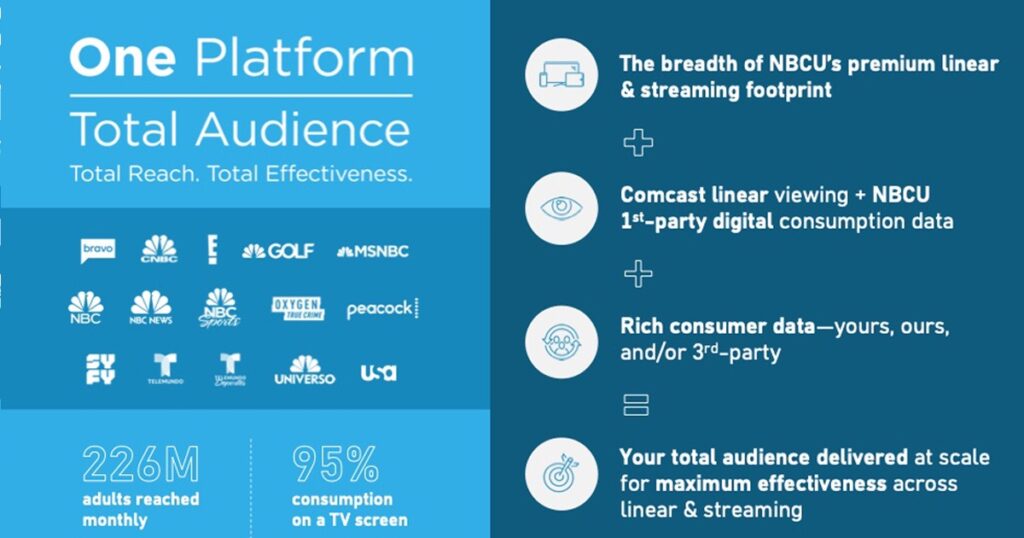
Image credit- AdWeek
What does it do?
With marketers in mind, One Platform Total Audience was created to open up new avenues for finding scale, generating incremental reach, and prioritizing brand safety. The technology, in particular, targets a brand’s particular audience segment and increases brand effectiveness by creating a single media plan across linear and streaming that combines machine learning and predictive analytics.
The whole collection of content from NBCUniversal is available on One Platform Total Audience. To more effectively reach the customers that matter most to brands at an unmatched scale and with program-level transparency into delivery, the technology makes use of the company’s extensive first-party data as well as the data sets of advertisers. The main idea behind One Platform Total Audience is to utilize CES as a venue for announcing One Platform updates, such as last year’s breakthroughs in identity and data technologies. Over the years, the company has made large investments in this technology to change the way that deal-making works in the advertising industry. Thanks to technology, marketing strategies can now be more responsive and flexible, allowing them to change with changing consumer preferences.
Read More: AdTechStats 2023 By ADScholars: Understanding the Ad Trends To Strategize Advertising in 2024.
New investments in advanced advertising tech
NBCUniversal has made significant investments in cutting-edge advertising technologies. The company claims that with the full-scale launch of One Platform Total Audience in 2024, it is “arriving at the pinnacle of its commitments by bringing together its capabilities across all screens.”
The most recent developments that enable this are:
Fresh automation
One Platform Total Audience will identify an optimal media mix to engage marketers’ specific audience segments by using machine learning to automate budget allocation across linear and streaming media. With One Platform Total Audience, NBCUniversal will also offer programmatic guarantees for media buys, resulting in more automated and turnkey streaming activation. Additionally, the business plans to implement new buy-side automated order and workflow management to simplify transacting with strategic audiences.
Better data interoperability
Advertisers and agencies now have more flexible and effective ways than ever to onboard their data thanks to interoperability integrations throughout the media ecosystem. All of these are designed with privacy as their top priority. With the expansion of NBCUniversal’s streaming portfolio, marketers can now reach their target audiences with greater scale and better match rates.
Leveraging interoperability throughout NBCU’s portfolio, the technology makes use of both advertisers and the company’s first-party data sets to more effectively and transparently reach target consumers. The machine learning feature of the offering optimizes the targeted media mix by automating budget allocation across streaming and linear advertising.
Read More: GroupM Announces Ad Innovation Accelerator for the Future of Advertising
Widespread advertising industry acceptance
To enhance agency planning systems, NBCU collaborated with its branding and agency partners to develop One Platform Total Audience. The One Platform Total Audience for Q1 2024 is fully booked in all major categories, including tech, automotive, and retail. In response to this widespread industry adoption among agencies and brands, the company announced that in Q2 2024, it will expand to One Platform Total Audience.
In an early One Platform Total Audience test, NBCU observed improved brand reach and efficiency along with a reduction in impression waste. Furthermore, compared to specific age and gender demographics for the same brands, advertisers experienced a 25% higher brand engagement rate. Nearly 60% of NBCUniversal’s advertising clients have made purchases in the last year, so building a system that can accommodate this increasing
Why is it important?
The goal of One Platform is to reconcile traditional advertising methods with consumers’ preferences for viewing content across all screens. As per NBCU, the One Platform technology stack offers marketers the data-driven products, services, and capabilities they require to accomplish their business objectives and enhance the viewer experience. The most recent offering from NBCU represents the industry’s change in attitude toward media.
Here’s what they said
Mark Marshall, chairman, of NBCUniversal Global Advertising & Partnerships said,
From day one, NBCUniversal has evolved its business to connect with consumers where they are, while giving advertisers a seat at the table. 2024 will be a watershed year for change. Seismic shifts in measurement will throw everyone’s media mix models up in the air, presenting a singular opportunity to transact on strategic audiences and measure real KPIs for marketers. With One Platform Total Audience, we are empowering our clients to supercharge their media schedules in a whole new way and maximize the effectiveness of their ad dollars to achieve their business goals.
Read More: Walmart and NBCUniversal Join Forces for Shoppable Ad on Bravo’s Show
GroupM Announces Ad Innovation Accelerator for Future of Advertising
WPP’s media investment division, GroupM, has announced the first-to-market GroupM Ad Innovation Accelerator, a program designed to redefine audience and advertiser engagement. Working together with a team of highly skilled TV/video programmers and developers, the company is investigating and creating new video ad formats that will be widely used in ad-supported streaming environments. Participating in the initiative are interactive TV developers BrightLine and KERV, as well as streaming providers Disney, Peacock, Roku, Telly, and YouTube.
Ad Innovation Accelerator
The goal of the Ad Innovation Accelerator, led by GroupM’s investment team that leads the industry, is to transform the 30-second ad spot for streaming audiences while improving brand-viewer relationships and producing quantifiable outcomes for participating GroupM advertisers. The working group will plan and develop scalable ad formats that are intended to be widely used in ad-supported streaming environments with a shared vision. The first users of this program will be Mindshare, Wavemaker, and EssenceMediacom clients of GroupM in North America.
First-to-market program
GroupM described the initiative as a “first-to-market program aimed at redefining engagement between advertisers and audiences,” but it was unclear how long use of the formats would remain exclusive to GroupM clients and if/when they would be made available to other advertisers and agencies. This program discusses evolving viewer preferences and suggests a possible way to advertise streaming services more successfully. Additionally, it aims to improve the relationship between viewers and brands, providing advertisers who work with GroupM with quantifiable results.
GroupM’s Ad Innovation Accelerator plans
This Year, Next Year 2023 End-of-Year Forecast from GroupM predicts that CTV advertising in North America will rise 14.9% in 2024, up from 9.4% in 2023. Early in 2024, the newly established working group will meet. GroupM’s Ad Innovation Accelerator partners have mutually decided to:
- Arrange quarterly meetings and recurring innovation sessions to set objectives. Decide on outputs for newly developed advertising models and techniques.
- In Q1 2024, start pilot projects.
- Utilizing test-and-learn methods, co-create advertising formats for agnostic use throughout the media ecosystem.
- Examine the effectiveness and efficiency of media campaigns by applying the most recent standards and procedures.
Members of the working group will work closely with GroupM advertisers. They indicate a desire to test novel formats and procedures. Early in 2024, benchmark testing will be completed in advance of 2024-2025 upfront planning. Throughout 2024, GroupM’s Ad Innovation Accelerator will expand to additional markets. It will create and test novel ad formats for both established and new media.
Read More: GroupM and Google Announce Post Third-Party Cookie Readiness Program
Here’s what they said
Andrew Meaden, Global Head of Investment, GroupM said,
We have to craft a future of our industry where engagement, innovation, and outcomes converge. As we shape the next era of media where advertising works better for people, it is critical we continue to innovate new advertising experiences with our partners around the world to ensure brands are meeting audiences where they are. With more ad-supported options emerging, advertisers must respect audiences’ preferences and use cutting-edge technology to deliver more personalized content.
Mike Fisher, Executive Director, Investment Innovation, GroupM U.S. commented,
Brands advertising in ad-supported streaming environments have an incredible opportunity to engage with attentive consumers, but the rapidly evolving media landscape makes it difficult for advertisers to efficiently and resourcefully launch interactive advertising campaigns. Our clients need a simple way to activate interoperable and attributable campaigns across the ad-supported streaming ecosystem. With key stakeholders at the same table, we will shape impactful outcomes that allow advertisers to execute creative, engaging and effective campaigns.
Matt Sweeney, Chief Investment Officer, GroupM U.S. added,
Building on a legacy of setting industry benchmarks and driving responsible media investment, our program is rooted in shared discovery, proven success and forward-thinking. We’re encouraged by our partners’ collective commitments to impactful advertising and their leadership in advancing new ad formats, specifically for streaming video. Uniting partners with varying objectives to streamline ad development will have a multitude of benefits for our advertisers, ultimately allowing for quick iteration and better interoperability across platforms. That’s a win-win for our industry.
Read More: GroupM Bags INR 200 Crore Domino’s Pizza Account’s Media Mandate
Publicis Groupe South Asia Appoints Amitesh Rao as CEO, Leo Burnett South Asia
Amitesh Rao has been appointed Chief Executive Officer of Leo Burnett South Asia by Publicis Groupe South Asia. Rao takes over for Dheeraj Sinha, who left the agency to work for FCB last year. As part of his role, Rao will oversee all Leo Burnett India operations. It will include Leo Burnett Orchard, in Mumbai, Gurgaon, Bangalore, Chennai, and the rest of South Asia. Furthermore, he will oversee Publicis Business and Publicis Health.
Role and reporting within the agency
Working closely with Rajdeepak Das, Chief Creative Officer, Publicis Groupe India, and Chairman, Leo Burnett South Asia, the role will report to Anupriya Acharya, CEO, Publicis Groupe South Asia. Rao has been carefully chosen to guide Leo Burnett South Asia into its next phase of growth and creative aspirations because of his multidisciplinary and multicategory experience from a variety of leadership roles, impressive track record on client business, and abundance of knowledge across technology, data, and creativity.
Amitesh Rao’s leadership experience
Rao, an IIM Bangalore alumnus, has over 25 years of leadership experience in marketing, advertising, and technology entrepreneurship in the gaming and simulation industries. He comes from McCann India, where he oversaw operations in the North and West as Executive Director. Rao previously held executive roles at TBWA, Rediffusion, and JWT. During his time in advertising, he worked across markets for well-known brands. These included PepsiCo, Airtel, Nestle, Reckitt, Coke, Mastercard, and Nissan. He has worked with MTS and RPG in the telco and data sectors, handling marketing and sales.
Read More: Aalap Desai, Ex-CCO, Dentsu Creative India Launches TGTHR, a full-funnel ad agency
Here’s what they said
Anupriya Acharya, CEO, of Publicis Groupe South Asia said,
I am delighted to welcome Amitesh Rao. We are in an age of constant invention and re-invention and in Amitesh, we found the perfect leader who brings both a thorough appreciation of the power of creativity in building strong brands and an intimate understanding and fluency in diverse languages of technology, gaming, data, and platforms. His easy demeanour and candid attitude are an added asset for clients, our teams and our Groupe’s Power of One agenda. I look forward to working with him.
Amitesh Rao added,
I look forward to leading Leo Burnett South Asia in an era where the confluence of technology and creativity is redefining the playing field. With its outstanding creativity and top accolades, a remarkable roster of blue-chip clients and an amazing talent pool, the agency offers an incredible canvas. I hope to bring new perspective on client businesses, strengthen seamless solutions and look forward to accelerating growth for Leo Burnett and its clients.
Rajdeepak Das, Chief Creative Officer, Publicis Groupe India and Chairman, Leo Burnett South Asia commented,
Having built Leo Burnett South Asia over the last 10 years and making it synonymous with iconic, inspiring creativity that transforms brands and businesses, I am delighted to find in Amitesh a leader who resonates with LB’s ethos and brings with him strong and diverse experience that can take Leo Burnett South Asia to the next level of success and build on the agency’s stellar offerings. We all look forward to partnering him.
Read more: Starcom Middle East Appoints Donnacha Kinsella as Head for Saudi Arabia
Google Reaches $5 Billion Class-Action Privacy Lawsuit Settlement
Google has reached a settlement to resolve a $5 billion class-action privacy lawsuit. It claimed the tech giant improperly tracked users’ personal information. It did so when it used the incognito mode of its Chrome browser and other similar “private” modes in other browsers to monitor their online activities. In 2020, a lawsuit was filed alleging that Google had deceived users into thinking that using Incognito mode would prevent it from tracking their online activities. The lawsuit claimed that despite users using ostensibly “private” browsing, Google’s advertising technologies and third-party websites that used Google Analytics or Google Ad Manager kept track of users’ site visits and activities, sending the data back to Google servers.
The proposed trial
A trial in the proposed class action was set for February 5, 2024. However, US district judge Yvonne Gonzalez Rogers in Oakland, California postponed it after Google and consumer attorneys announced they had reached a preliminary settlement in the lawsuit, which sought US$5 billion in damages. However, internal Google emails revealed in the lawsuit showed that the search engine giant was tracking users. They were especially the ones who were using incognito mode to measure web traffic and sell ads.
Read More: Publicis Media, UK AOP To Test Privacy-Enhancing Technology (PETs)
Google’s class-action privacy lawsuit
The plaintiffs had claimed that even when they switched Chrome and other browsers to “private” browsing mode, Google’s analytics, cookies, and apps allowed the Alphabet division to monitor their online activities. Additionally, the plaintiffs claimed that Google’s actions produced an “unaccountable trove of information” about people who believed they had taken privacy-protecting measures. It included everything from harmless information about friends, favorite foods, shopping routes, and pastimes to possibly embarrassing details. The plaintiffs’ attorneys requested at least $5,000 for each user. This would have cost at least $5 billion. However, the settlement will probably not come close to that amount. Furthermore, the parties did not provide a sum for their preliminary settlement.
Google has reached a settlement
The settlement was reached only a few weeks after Google’s request for a judge to decide the case was denied. Next year will see the start of a jury trial. Google was accused in the lawsuit of violating users’ privacy by “intentionally deceiving them with the incognito option.” It was filed in a Californian court. According to the initial complaint, Google and its staff members were granted the “ability to discover personal information about people’s lives, passions, and online activities.” By February 24, 2024, a formal settlement is anticipated for court approval. Class action lawsuits have emerged as the primary means of challenging large tech companies on data privacy issues. This is because the US does not have a comprehensive law governing the handling of personal data.
Read More: IAB Tech Lab Launches Two Working Groups for AI and Privacy Sandbox
Magna Global’s Hatem Fakih Reveals Strategies for Thriving in GCC’s Media Landscape
Hatem Fakih, the Business Director at Magna Global, brings a wealth of expertise to the dynamic world of media and advertising. His leadership navigates the complexities of the industry, ensuring growth, profitability, and a forward-thinking approach. In this exclusive interview, his insights delve into navigating GCC markets, leveraging technology, and fostering collaborative success.
Your tenure in the media and advertising industry has been long and varied. Could you share your reflections on how your journey has evolved along with your learnings and how these have been applied in your roles?
Throughout my extensive tenure in the media and advertising industry, I’ve navigated the dynamic GCC markets, rich in diversity and evolving consumer behaviors. An essential insight for me is the significance of understanding cultural intricacies shaping consumer preferences. The diverse demographics in the region demand a nuanced approach to media strategies.
I’ve learned to tailor campaigns to resonate with local values, ensuring genuine connections with the community. My journey highlights technology’s pivotal role in shaping the media landscape. The rapid adoption of digital platforms and the prevalence of social media emphasize staying abreast of technological trends. Leveraging data-driven insights and innovative digital marketing approaches is crucial for effective audience engagement.
In various roles, I’ve applied these learnings by fostering adaptability and innovation. Encouraging a forward-thinking mindset and openness to emerging technologies is vital for staying ahead in this ever-evolving market. Collaboration is a cornerstone of success in the Gulf market. Building strong relationships with local partners, influencers, and media vendors enhances campaign reach and deepens understanding of market dynamics. This collaborative approach navigates the intricacies of the GCC market, fostering long-term success.
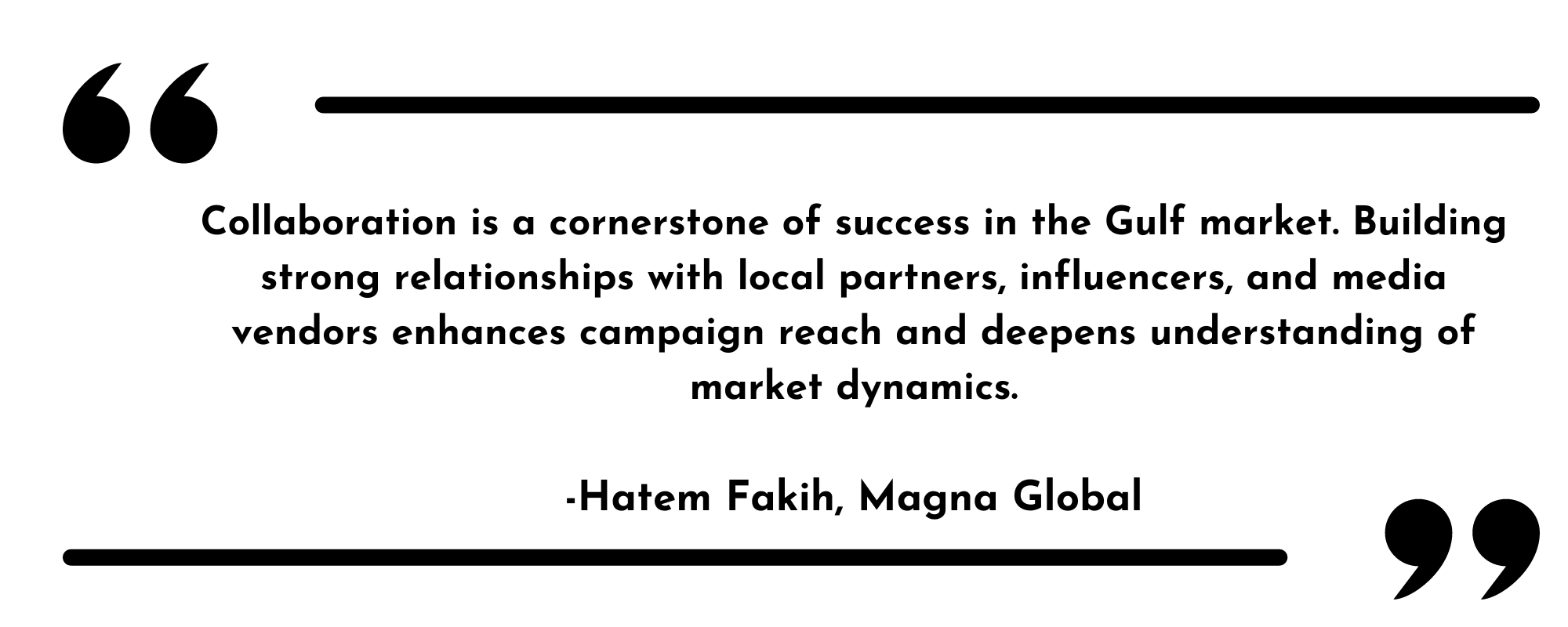
As Magna Global’s Business Director, how do you ensure that all the strategies you create align with your clients’ visions and marketing goals? What KPIs do you monitor and how do you ensure that they are met?
As the Business Director at Magna Global for the Gulf market, aligning strategies with clients’ visions and marketing goals involves a multifaceted approach.
i. Client Collaboration: We regularly engage with clients to understand their business objectives, long-term visions, and specific marketing goals. This includes conducting comprehensive briefings and workshops to gather insights and align expectations.
ii. Market Research & Analysis: Our delivered strategies are customized and tailor-made to resonate with market dynamics and target audiences and stay on top of market trends and advertisers’ activities.
iii. Customized Strategies and Agile Strategies Adjustments: Our approach is based on customized strategies that seamlessly integrate with clients’ brand identities, resonating with the GCC market’s cultural nuances. We ensure these strategies address specific challenges and opportunities unique to the region. Additionally, we remain agile and ready to adjust based on evolving market dynamics.
iv. Continuous Learning: We stay updated on emerging trends, technologies, and best practices in marketing to continually refine and enhance our strategies for optimal results.
How do you navigate the intricacies of the media landscape and keep updated with the current market and consumer trends?
Navigating the media landscape and staying updated with the current market and consumer trends in the Gulf region demands a multilayered approach, including but not limited to research, media consumption habits, local partnerships, cultural adaptability, and data and analytics.
Publishers are divided on Google’s third-party deprecation and whether it is a strategic mistake or something to embrace. What is your take?
As a professional, I see this as a significant development towards greater privacy, a user-centric approach, and data protection. However, in our region, we face certain challenges. This will affect our ad targeting and was evident when Apple updated their IOS, restricting advertisers without consent. Nevertheless, I also perceive this as a call for innovation within our industry—whether through new technologies or inventive approaches to reaching our audiences.
As a consumer, I’m becoming increasingly conscious of privacy, and there’s a growing demand for transparent and privacy-friendly practices. Media agencies and advertisers that embrace privacy-enhancing technologies may be viewed more favorably by users.
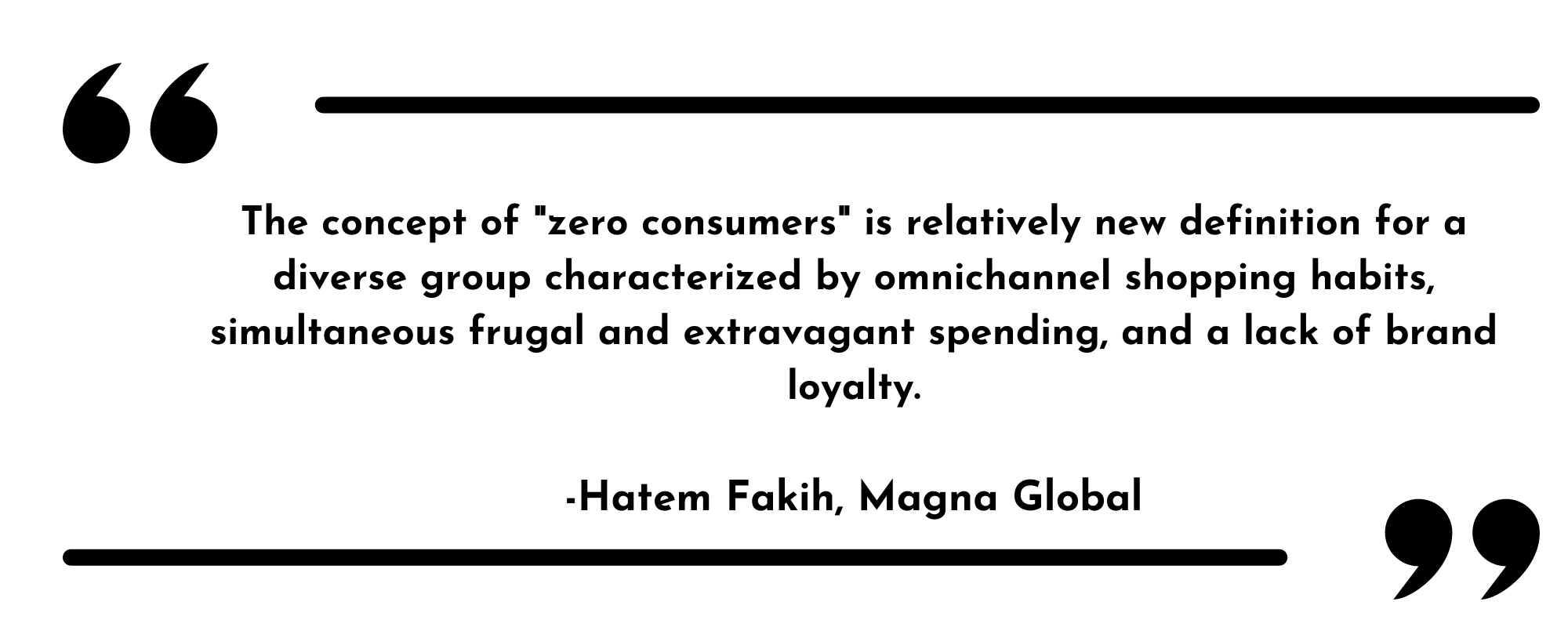
Changing spending habits, omnichannel shopping, and much more are changing how modern consumers or “zero consumers” shop. How can companies attract them and gain an edge over their competitors?
The concept of “zero consumers” is relatively new definition for a diverse group characterized by omnichannel shopping habits, simultaneous frugal and extravagant spending, and a lack of brand loyalty. Health and sustainability concern this group, though it doesn’t always translate into a willingness to pay more. Ignoring their preferences risks rendering companies irrelevant.
Consumer companies face the challenge of understanding and meeting the needs of zero consumers while staying ahead of technological, talent, and competitive trends. There are some defined imperatives to gain an edge over this group including reimagining the omnichannel experience, overhauling consumer propositions, scaling up personalization, and reshaping societal impact. The success of these strategies hinges on proper execution and adaptation to the changing landscape marked by evolving technology, talent competition, and shifting consumer behavior.
In recent years, big brands all over the world have adopted CGI or FOOH advertising because of its cost-efficiency and low engagement levels. How do you think this trend will progress?
CGI technologies empower brands to craft visually stunning and attention-grabbing content without the logistical challenges and costs tied to traditional methods. As technology advances, the quality of CGI continually improves, potentially driving increased adoption as brands seek more realistic and immersive ways to showcase their products or services.
Additionally, brands may leverage CGI for highly personalized and targeted advertisements, providing a more engaging and relevant experience for audiences. Another avenue is integrating CGI with AR and VR to create interactive and immersive experiences, fostering more engagement with out-of-home (OOH) advertising. However, this integration poses the challenge of differentiating between real content and CGI content.
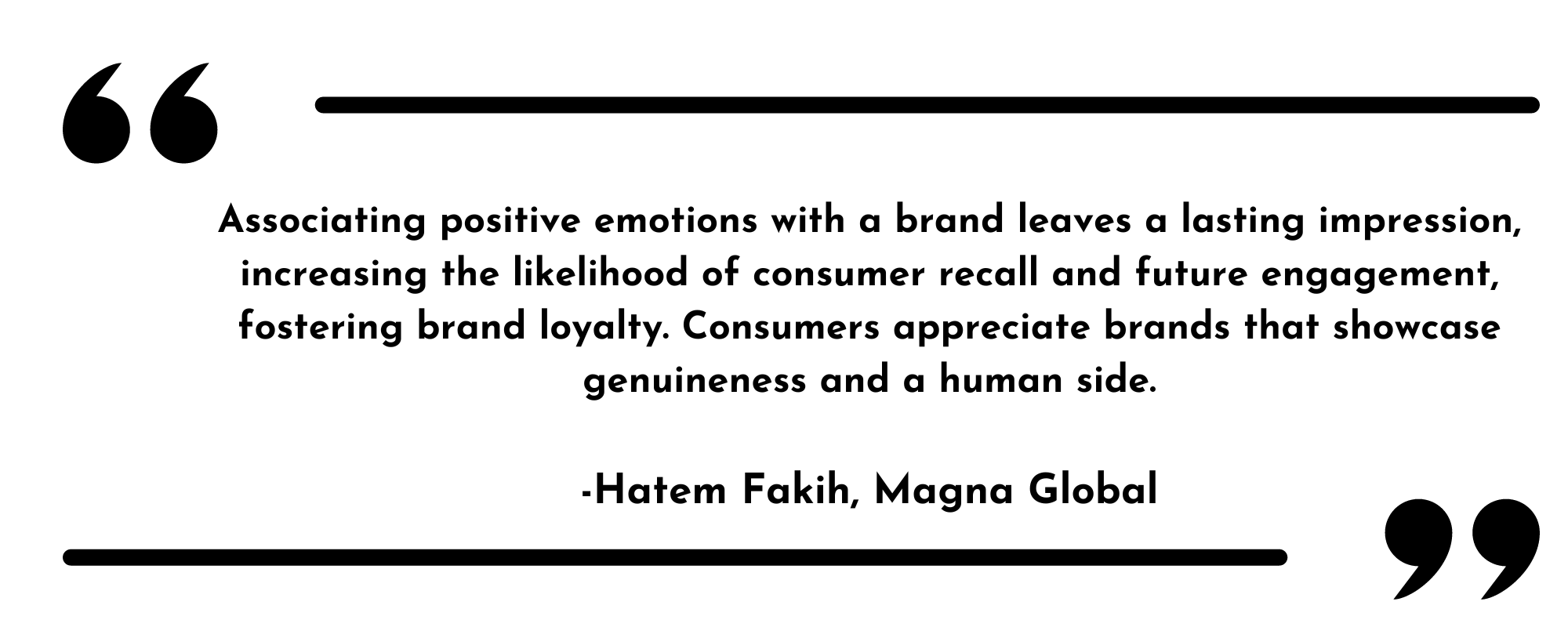
Brand-building isn’t enough in today’s consumer market. Consumers need unique brand experiences to keep coming back. What are the benefits of emotions being incorporated into marketing?
Presently in media, we’ve begun examining the attention metric, focusing on eliciting various emotions to create memorable and emotionally charged experiences. Associating positive emotions with a brand leaves a lasting impression, increasing the likelihood of consumer recall and future engagement, fostering brand loyalty. Consumers appreciate brands that showcase genuineness and a human side.
Addressing emotional needs can significantly enhance overall customer satisfaction. Brands attuned to and responsive to the emotional triggers of their customers are better positioned to craft products, services, and experiences aligning with customer expectations. This understanding plays a pivotal role in decision-making, influencing purchasing decisions and shaping consumer behaviors.
Emotional experiences possess a viral quality. When consumers have a positive emotional reaction to a brand, they’re inclined to share their experiences, contributing to word-of-mouth marketing and potentially creating viral content. This emotional connection amplifies the brand’s reach and impact.
If there is an ongoing or upcoming advertising/media trend that you would never want to bring back, what would it be and why?
Disruptive advertising formats and approaches are something that no one would like to see making a comeback. As media evolves, focusing more on entertainment, consumers are becoming selective in their content consumption. Disrupting this journey can lead to a negative perception of the brand or product being advertised.
Havas May Become A Separate Entity As Vivendi Considers Three-Way Split
The share price of French media conglomerate Vivendi has surged. This is a result of its potential split into three distinct listed companies. In an attempt to increase the value of his company, French billionaire Vincent Bollore is considering dissolving his vast media and entertainment conglomerate, Vivendi SE. The plan calls for the roughly €10 billion ($10.9 billion) French conglomerate to be divided into three separate businesses: the Pay-TV division, Canal+; the advertising and communications branch, Havas; and a business that includes its majority stake in the publishing group, Lagardère Group.
Vivendi contemplates a three-way split
The company argues that this is because, as a unified entity, its shares are sold at a discount, which limits its capacity to carry out its intended expansion plan. The value of the various entities would be maximized by splitting them into three companies. Vivendi claims that splitting itself into three sections will allow it to fully realize the development potential of all of its operations. Each of its three business divisions is currently seeing rapid growth in the global market, which is accompanied by a wealth of investment opportunities.
Rise in revenue and profit valuations
Should the split proceed, Havas and Canal+, Vivendi’s primary revenue and profit stream, will be spun off as independent businesses. After separating from their parent company, this could result in valuations of roughly €3 billion for Havas and €6.1 billion for Canal+. Regarding its €1.3 billion ($1.4 billion) ownership of the former telecom monopoly Telecom Italia SpA, Vivendi is also exploring options.
Subsequently, the organization intends to establish a third publicly traded division as an investment firm. It would accommodate Lagardère and encompass additional listed and unlisted assets in media and entertainment firms. To investigate a possible split, Vivendi will consult its “usual” banks and advisors. Any strategy must benefit all parties involved and consider tax implications. The market valuation of the three distinct entities might be roughly 40% higher than their current valuation.
Read More: Havas Announces Majority Stake Acquisition in PR Pundit in India
Vivendi’s split from Universal Music Group
The news comes two years after Vivendi split from Universal Music Group in a highly successful IPO. This gave shareholders ownership of 60% of the company’s shares. The board is now permitted to investigate the possibility of dividing into three companies. Ad holding company Havas Group would once again become an independent publicly traded company if the plan is approved. This was the case until Vivendi purchased it in 2017.
It’s an indication of how Bollore, the industrialist and corporate raider who invested in Vivendi for the first time in 2011, is still shaping the organization. He is essentially leading even though he is no longer the chair. 2018 saw him fold into another business he owned, the advertising agency Havas, after first selling off his video game and telecom assets. At the time, he held just under 30% of the group’s shares.
Vivendi’s efforts for business synergies and cohesion
For a considerable time, investors and Vivendi have been frustrated by the group’s operating businesses’ lack of coherence and synergies. Since his father’s official retirement in 2022, Yannick Bollore has been working to make things better. Vivendi declared that it would evaluate the viability of the suggested split. It would take into account the tax implications for shareholders, in collaboration with banks and other advisors. There was no deadline given for finishing the assessment, but information will be shared “in due course.” The split plans were announced only a few weeks after Vivendi effectively acquired the rival Lagardère group, expanding its holdings to include publishing house Hachette.
Read More: Havas Acquires EPROFESSIONAL, a Hamburg-based Digital Performance Marketing Agency

